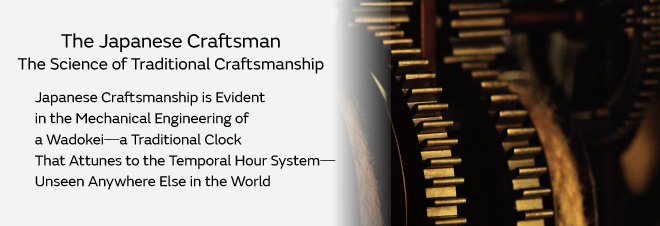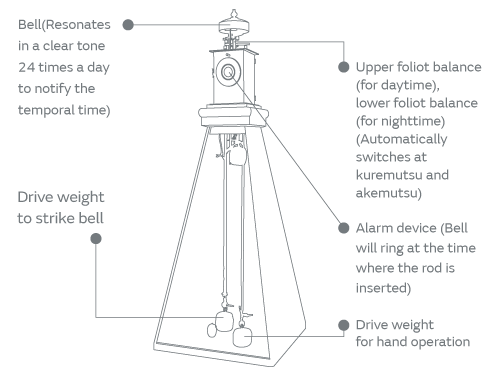
Based on an interview with Takuro Naluse, clockmaker and founding director of NALUSE TOKEI Co,Ltd.
Before the Meiji Period (1868–1912), Japan used a time schedule that was far more complicated than what we know today. Day and night were each partitioned into six equal parts called koku, but because sunrise and sunset times vary depending on the season, the length of the koku also changed from day to day. The traditional Japanese clock called wadokei was developed to adapt to this “temporal hour system,” a time concept that followed the sun. What sort of mechanical engineering swayed the evolution of clockwork away from the Western “fixed hour system” that ticks the time equally all day and all night? To find out, we spoke with the only wadokei maker in Japan, Takuro Naluse of NALUSE TOKEI Co., Ltd.
Japan’s Engineering Industry was Founded on “Amusement,” Not the Pursuit of Accuracy
With almost no reliable literature on traditional Japanese clocks, the origin of wadokei is not clear. According to the "Owari-shi" (a periodical from the Owari territory) compiled in 1832, “a blacksmith named Sukezaemon Tsuda repaired a clock that had been a gift to Tokugawa Ieyasu from Korea, and then used it as a model to create a new clock, which he offered to Ieyasu.” This is known to be the first mechanical clock made by a Japanese. Tsuda’s descendants remained in Owari and earned a great reputation serving the Owari Tokugawa Family as clockmakers for generations. “Nagoya’s thriving engineering industry today has its roots in this history,” says Mr. Naluse, whose home is also Nagoya.
Later, clock-making craftsmen, pioneered by Tsuda, remodeled imported“fixed hour” clocks to suit the Japanese “temporal hour system” that tells time differently depending on the season. The problem was that these clocks were handmade by craftsmen and as such, were quite expensive. Only a member of the shogunate, a feudal lord, or a wealthy merchant could afford one. Particularly elaborate clocks with delicate craftsmanship known as Daimyo (feudal lord) clocks were often owned to show authority. Once the technology popularized towards the end of the Edo Period, the clocks became available to wealthy townspeople. Again, practicality did not seem to be an issue. When the sun rose, people went to the fields. When it went down, they returned to their homes. In those days, the center of Japanese life was farming. They had no need to know the time anyway.
So then why did the traditional Japanese clocks exist? Mr. Naluse says, “They invested high technology into something they didn’t need. It was obviously amusement.” Almost excessive detail to the gear, decorative grace, the stately pedestal; the wadokei made its own evolution as a status symbol from start to finish, or an exclusive collector’s item for the enjoyment of mechanical engineering. It is interesting that the focus of technology is fundamentally different from the Western clock that insists on accurate time measurement.
The Temporal Hour System is a Healthy and Natural Time System Based on the Movement of the Sun
In order to understand the traditional Japanese clock wadokei, one must first understand the “temporal hour system,” which was the concept of time during the Edo Period (1603–1868). The method that divides the entire day into equal parts is called the fixed hour system. Commonly throughout the world today, our day is divided into 24 equal parts. Conversely, the temporal hour system separates daytime from nighttime and partitions those into six equal parts each. The most noticeable feature is that since day and night are different lengths depending on the season, this changes the length of the divided units of time. For people who are used to the fixed hour system, to have to depend on the sun to tell what time it is would likely be very inconvenient. In an agrarian society however, it is actually quite convenient. In Mr. Naluse’s words, “The temporal hour system based on the movement of the sun was a healthy and natural time system.”
A Temporal Hour Mechanical Clock Showered with Japan’s Own Ingenuity
The World’s Only Successful Mechanization of a Complicated Time System Called the Temporal Hour System
In order to attune a Western mechanical clock that measures time at fixed intervals to follow the Japanese temporal hour system, two things needed to be done. One was to adjust the daily flow of time through day and night. The other was to make adjustments so that the length of day and night corresponded to the seasons. The craftsmen of the day then invented a device called a tempu (foliot balance) that could change the speed at which the clock was moving. Positioned under the bell, the horizontal comb-like bar with the weights attached is the tempu. It moves back and forth, controlling the speed of the clock’s movement like a pendulum. When the weights are pushed apart, the clock moves slowly. When they are brought together, it gains speed. Twice a day, once with the dawn and once at sunset, the weights were moved. Furthermore, both positions needed to be further adjusted slightly according to the season. This mechanism that uses one foliot balance was called the single foliot balance (tempu) system and is known to be the mechanism used in the first wadokei. The single foliot balance system was time-consuming because the weight positions need to be adjusted frequently. To save the extra time and effort, the craftsmen developed a double foliot balance system that has one tempu each for night and day and switches over automatically. This wadokei tells the time for day and night separately, but this doesn’t mean that it has two mechanical components. It has a double speed control mechanism, the tempu and escapement (a device that provides intermittent force to the vibrator to sustain vibration), and switches automatically. Because of this, it was no longer necessary to move the weights every day. Adjustments only had to be made twice a month in accordance with the length of day and night depending on the season. Also, the double-foliot balance system had an alarm clock-like feature that rings a bell when a rod is inserted to the desired time on the dial.
The Technology Applied to the Wadokei is the Starting Point of Valuable Craftsmanship
Since we have switched to the modern fixed hour system, traditional Japanese clocks have inevitably had their final days and can now only be seen in museums. According to Mr. Naluse, who has worked to revive the clocks, the number of existing wadokei is very limited and hardly any literature concerning their production remains. In such circumstances, he started his own production based only on his curiosity and inquisitive mind. In the process, he found that the craftsmen of the day were making the clocks with a different aim than those with a modern idea of craftsmanship. For example, take the shape of a single gear. Each tooth is polished right down to its roots at a right angle with a file to show the beauty of the gear. Extensive detail and consideration are paid to other parts too, that have nothing to do with the function of the clock. The tower that contains the drive weights is deliberately made to open and close, only to show what’s inside. “Effort is concentrated on parts that cannot be quantified,” says Mr. Naluse. “Those people knew the most delectable aspects of the mechanical industry.” He says that in a sense, this kind of irrational non-functioning use of technology is uniquely Japanese.
Fascinated by the reproduction of these traditional Japanese clocks, Mr. Naluse has begun to realize what it means to craft something of value. The wadokei that he revives into the modern age too, is created with thorough elaboration down to shaping the gears and defining the details of other parts. With a one of a kind design and a mysterious ticking sound, his mechanism is an expression of the concept of time brought from ancient Japan. The wadokei teaches us that it is the time and effort a craftsman puts into his work that creates value. The cool tone of the resounding bell of quality metal almost sounds like a wake-up call to the modern Japanese manufacturing industry that condones mass production.
The Wadokei Display
Time for the entire day and night was represented by the 12 signs of the Chinese zodiac and called by the signs, such as time of the rat (nenokoku), time of the bull (ushinokoku) and so on. Noon was the time of the horse (umanokoku). The character for horse is still used to mean noon, today. Numbers were also used in the temporal hours system, in addition to the Chinese zodiac. This was not out of necessity for numerical display, but meant for people to hear the number of times the temple bell rang to inform the time. The time just before dawn when the stars disappeared was called “akemutsu (meaning rising six)” and the time after sunset when the stars became visible, “kuremutsu (meaning setting six).” After that, the order of time for both day and night was itsutsu (five), yotsu (four), kokonotsu (nine), yatsu (eight), and nanatsu (seven). This is an unusual sequence but it was derived from the ideas of the Book of Changes.

Parts of the lantern clock with double-foliot balance